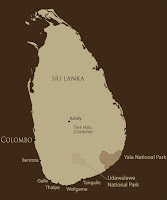Yala National Park or Ruhuna National Park is the second largest and most visited national park in Sri Lanka. Yala is situated in the southeast region of the country, and lies in Southern Province and Uva Province. The park covers 979 square kilometres (378 sq mi) and is about 300 kilometres (190 mi) from Colombo. It had originally had been designated as a wildlife sanctuary in 1900, and, along with Wilpattu it was one of the first two national parks in Sri Lanka, having been designated in 1938. The park is best known for its variety of its wild animals. It is important for the conservation of Sri Lankan Elephants and aquatic birds.
There are six national parks and three wildlife sanctuaries in the vicinity of Yala. The park is situated in the dry semi-arid climatic region and rain is received mainly during the northeast monsoon. The national park hosts a variety of ecosystems ranging from moist monsoon forests to freshwater and marine wetlands.
Yala is one of the 70 Important Bird Areas (IBAs) in Sri Lanka. Yala harbours 215 bird species including six endemic species of Sri Lanka. The number of mammals that has been recorded from the park is 44, and it has one of the highest leopard densities in the world. The area had been a centre of past civilisations. Two important pilgrim sites, Sithulpahuwa and Magul vihara, are situated within the park. The number of visitors has risen in 2009 since the security situation in the park improved.
For a quarter century, Sri Lanka seems to have been plagued by misfortune, including a brutal civil war between the government and a separatist Tamil group. But the conflict finally ended last May, ushering in a more peaceful era for this teardrop-shaped island off India’s coast, rich in natural beauty and cultural splendors.
The island, with a population of just 20 million, feels like one big tropical zoo: elephants roam freely, water buffaloes idle in paddy fields and monkeys swing from trees. And then there’s the pristine coastline. The miles of sugary white sand flanked by bamboo groves that were off-limits to most visitors until recently are a happy, if unintended byproduct of the war.
The island, with a population of just 20 million, feels like one big tropical zoo: elephants roam freely, water buffaloes idle in paddy fields and monkeys swing from trees. And then there’s the pristine coastline. The miles of sugary white sand flanked by bamboo groves that were off-limits to most visitors until recently are a happy, if unintended byproduct of the war.



No comments:
Post a Comment